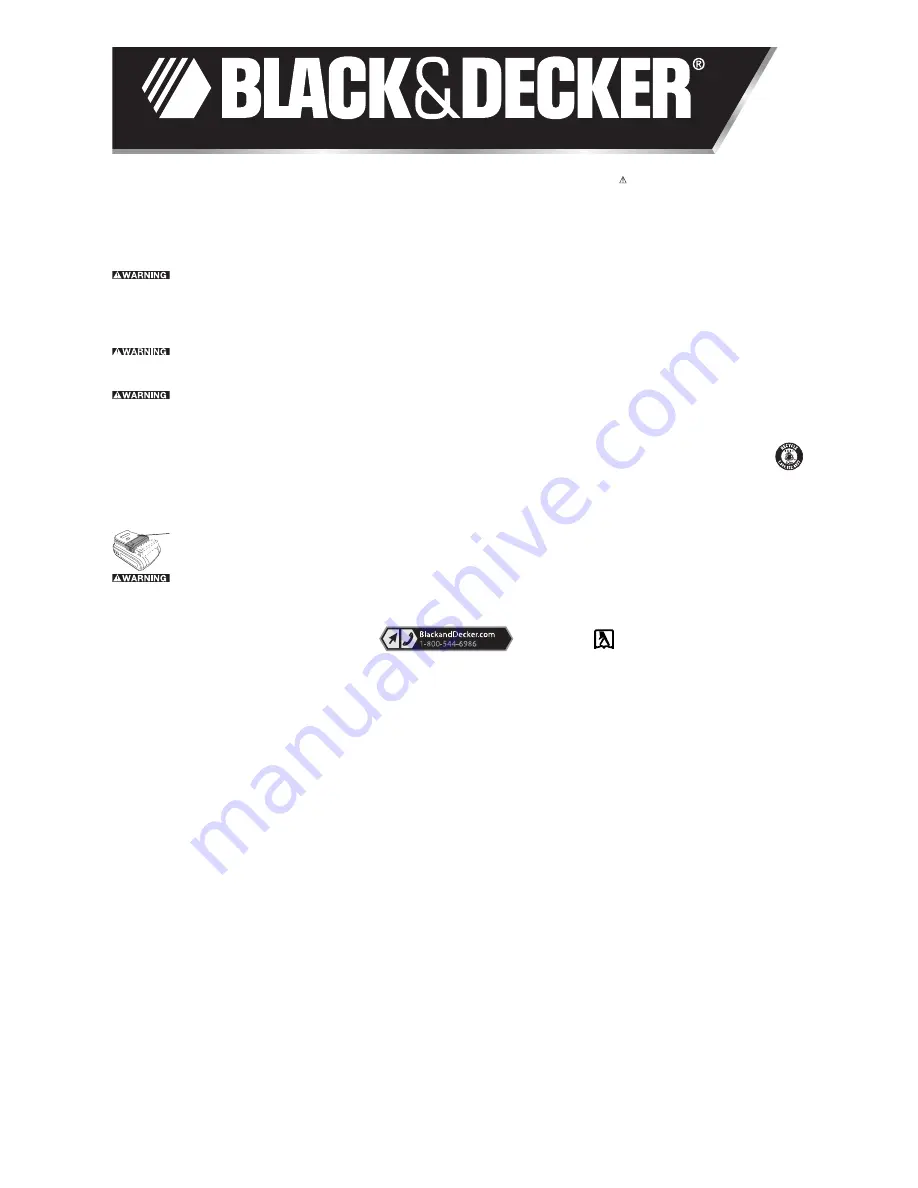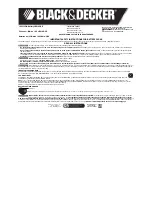
IMPORTANT SAFETY INSTRUCTIONS FOR BATTERY PACKS
The battery pack is not fully charged out of the carton. Before using the battery pack and charger, read the safety instructions below. Then follow charging procedures.
READ ALL INSTRUCTIONS
To reduce the risk of injury, basic safety precautions should always be followed including:
•
Do not incinerate the battery pack even if it is severely damaged or is completely worn out.
The battery pack can explode in a fire. Toxic fumes and materials are created when
battery packs are burned.
•
Do not charge or use battery in explosive atmospheres, such as in the presence of flammable liquids, gases or dust.
Inserting or removing the battery from the charger may ignite
the dust or fumes.
•
If battery contents come into contact with the skin, immediately wash area with mild soap and water.
If battery liquid gets into the eye, rinse water over the open eye for 15 minutes
or until irritation ceases. If medical attention is needed, the battery electrolyte for LI-ION batteries is composed of a mixture of liquid organic carbonates and lithium salts.
•
Contents of opened battery cells may cause respiratory irritation.
Provide fresh air. If symptoms persists, seek medical attention.
Burn hazard.
Battery liquid may be flammable if exposed to spark or flame.
•
Charge the battery packs only in
Black & Decker
LI-ION compatible chargers.
•
DO NOT splash or immerse in water or other liquids.
This may cause premature cell failure.
•
Do not store or use the tool and battery pack in locations where the temperature may reach or exceed 105°F (40C˚) (such as outside sheds or metal buildings in summer).
Never attempt to open the battery pack for any reason. If battery pack case is cracked or damaged, do not insert into charger. Do not crush, drop or damage battery pack. Do not
use a battery pack or charger that has received a sharp blow, been dropped, run over or damaged in any way (i.e., pierced with a nail, hit with a hammer, stepped on). Damaged battery packs
should be returned to service center for recycling.
IMPORTANT CHARGING NOTE
Read manuals originally supplied with charger and tool before charging and using this battery. The batteries should be recharged when they fail or produce sufficient power on jobs which
were easily done previously. DO NOT CONTINUE to use the tool with its batteries in a depleted condition.
THE RBRC™ SEAL
The RBRC™ (Rechargeable Battery Recycling Corporation) Seal on the LI-ION battery (or battery pack) indicates that the costs to recycle the battery (or battery pack) at the end of its
useful life have already been paid by Black & Decker.
RBRC™ in cooperation with Black & Decker and other battery users, has established programs in the United States to facilitate the collection of spent LI-ION batteries. Help protect our
environment and conserve natural resources by returning the spent LI-ION battery to an authorized Black & Decker service center or to your local retailer for recycling. You may also contact
your local recycling center for information on where to drop off the spent battery.
RBRC™ is a registered trademark of the
Rechargeable Battery Recycling Corporation.
BATTERY CAP INFORMATION
Battery storage and carrying caps are provided for use whenever the battery is out of the tool or charger. Remove cap before placing battery in charger or tool.
Fire hazard. Do not store or carry battery so that metal objects can contact exposed battery terminals.
For example, do not place battery in aprons, pockets, tool boxes,
product kit boxes, drawers, etc., with loose nails, screws, keys, etc.
Transporting batteries can possibly cause fires if the battery terminals inadvertently come in contact
with conductive materials such as keys, coins, hand tools and the like.
The US Department of Transportation Hazardous Material Regulations (HMR) actually prohibit transporting batteries in
commerce or on airplanes (i.e., packed in suitcases and carry-on luggage) UNLESS they are properly protected from short circuits. So when transporting individual batteries, make sure that the
battery terminals are protected and well insulated from materials that could contact them and cause a short circuit.
NOTE: LI-ION batteries should not be put in checked baggage.
:
:
:
:
SAVE THIS MANUAL FOR FUTURE REFERENCE.
Battery Cap
INSTRUCTIVO DE OPERACIÓN, CENTROS DE
SERVICIO Y PÓLIZA DE GARANTÍA.
ADVERTENCIA:
LÉASE ESTE INSTRUCTIVO
ANTES DE USAR EL PRODUCTO.
18V LI-ION Battery LB018OPE
Piles au LI-ION de 18V LB018-OPE
Baterías del LI-ION de 18V LB018-OPE
Instruction manual
Manuel d'instructions
Manual de'instrucciones
www.blackanddecker.com
See ‘Tools-Electric’
– Yellow Pages –
for Service & Sales
Black & Decker (U.S.) Inc.,
701 E. Joppa Rd.
Towson, MD 21286 U.S.A.




















